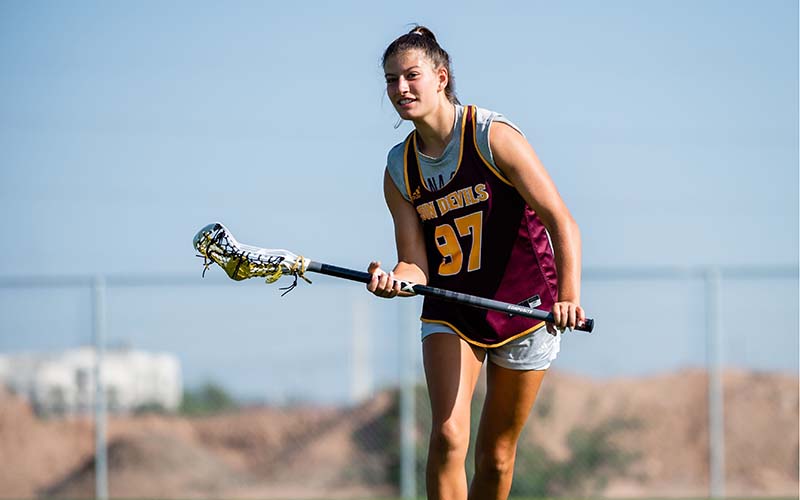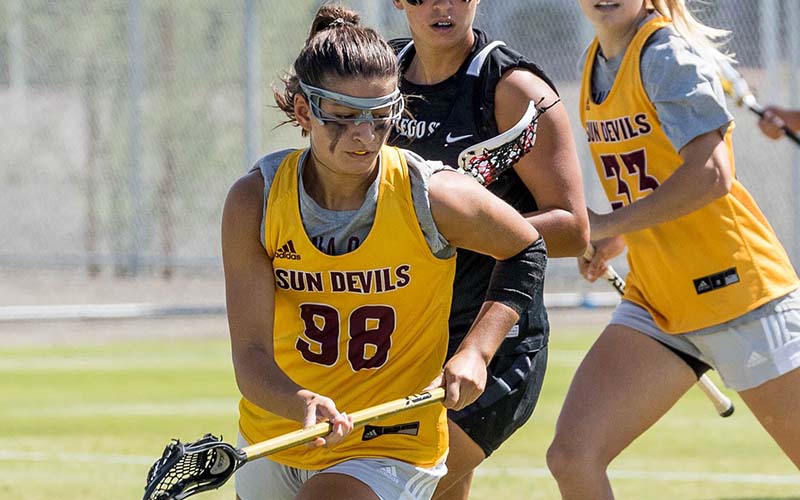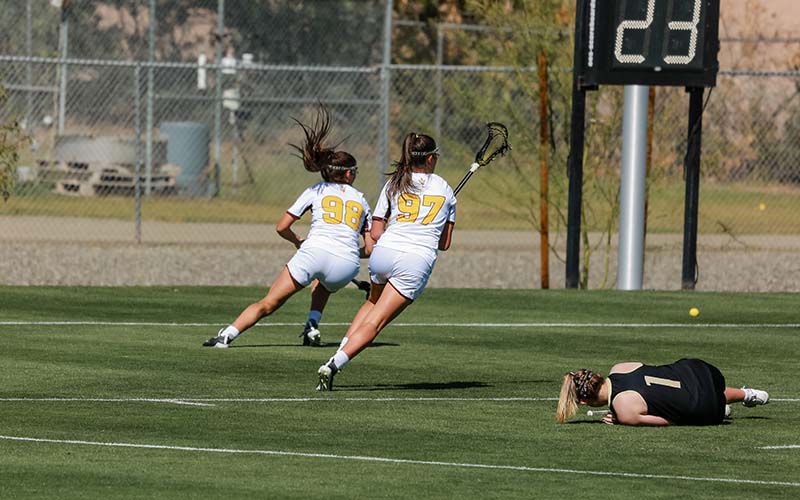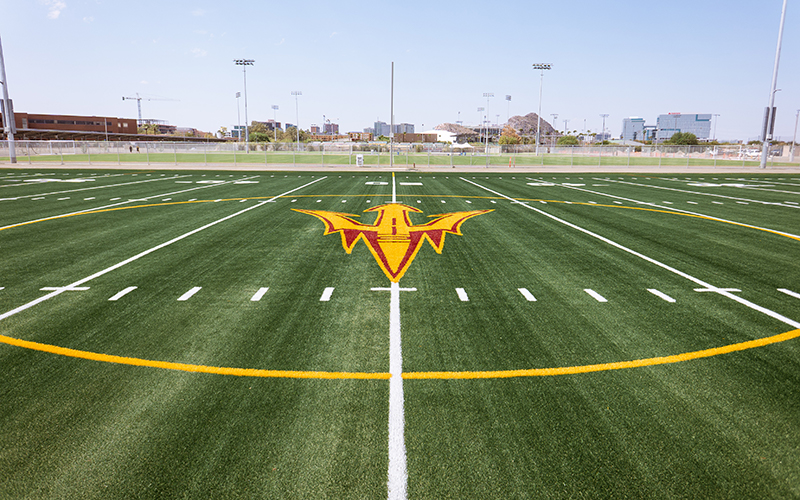TEMPE – Roy Gaspar recalls rushing to a hospital in Vancouver 19 years ago to join his pregnant wife, Sia, at an ultrasound test. A few days earlier, the couple had joked about the possibility that Sia would give birth to twins to join their 2-year-old son.
When Roy arrived, Sia looked at him and told him the news: It was no joke. They were going to be the parents of identical twins.
Roy turned to the ultrasound technician and asked, “Are you sure you know what you’re doing with that thing?”
The test was accurate.
And 31 weeks later, despite some serious doubts about whether both babies would survive the pregnancy, Sia Gaspar gave birth to twin girls, Isabella and Giulianna.
Now, the twins are better known by their nicknames, Bella and Gigi, and they are making their mark more than 1,500 miles away playing lacrosse at Arizona State.
As sophomores, the twins have become an integral part of ASU’s fledgling program, which is in just its fifth season of Division I competition.
Playing on the right side in ASU’s defensive and clearing scheme as a freshman last season, Bella led all position players in ground balls (43) and caused turnovers (17), earning First-Team All-Pac-12 honors. Gigi, who plays on the left side, wasn’t able to scoop as many ground balls as her sister, but still finished in a tie for third place on the team in caused turnovers (10).
The twins anchor the Sun Devil back line on the wings and are quickly becoming some of the most popular athletes at ASU due to their athletic prowess, as well as their presence on social media.
However, their journey to lacrosse stardom began long before they ever picked up a stick.
Trying it all
The twins were in ballet as 3-year-olds. They started playing soccer at 4. Next, in typical Canadian fashion, they learned to skate and handle themselves on the ice.
By the time they were in the third grade, the twins were immersed in sports. They played lacrosse, basketball, competed in gymnastics, field hockey, volleyball, track and field, cross country, swimming, even wrestling.
Their favorites were basketball, soccer and lacrosse, including both box and field versions of the sport.

Bella Gaspar believes that on the field, she and her twin sister “basically work with one brain.” (Photo courtesy of ASU Athletics)
Roy and Sia Gaspar allowed the twins to try any sport they chose with one caveat:
“We would always let them join and try anything they wanted,” Roy said. “But once they had joined, they couldn’t quit. It went both ways. They either had to see it through, or not see it at all.”
That important footnote came into play when the twins decided to sign up for box lacrosse, which is typically played during the summer on ice rinks that are covered with turf. It’s a more intimate, physical version of the more familiar field lacrosse because of the smaller, tighter playing surface.
Their childhood ice hockey coach was overseeing the team, and he was eager to have the twins involved. Bella quickly joined, however, Gigi wasn’t as enthusiastic when she saw how physical the box game was.
“A lot of our friends had been coming out with concussions,” Bella said. “At the beginning, Gigi was like, ‘I don’t know if I want to do this,’ so she stuck with field hockey while I played box.”
Roy recalls a slightly different version of the story.
“(For) whatever reason (Gigi was hesitant), but after the first game she saw how much fun Bella was having and wanted to play,” Roy said. “But I said, ‘Sorry, you said no.’ The coach would’ve taken her, but we told him that she said no and wasn’t in a place where she could suit up that year. We told him she’ll play next year.”
It’s little wonder the stories vary. After all, at any given time the twins were enrolled in at least three sports every season of the year between school and club teams.
Their brother, Zachary, is just 20 months older than the pair, and with both parents holding down jobs, getting the Gaspar kids to their sports commitments became a never-ending logistical challenge for their parents.
And their goal was to attend as many practices and games as possible, maintaining a constant presence in their children’s lives.
“It’s crazy reflecting on it,” Gigi said. “We would go from school to soccer in the pouring rain, our mom or dad would pick us up, bring us a change of clothes, then one of them would take us to our hockey game. And then after the hockey game, we would have basketball practice. We would have three sports in one night.
“I’ll never understand how (Roy and Sia) never complained.”
Making it work
Roy said that he and Sia found a way because, when he was growing up his parents were not able to attend as many of his activities as he hoped they would, so he resolved to be there when he became a parent.
“We would never miss a game or practice unless we had to divide and conquer with our son’s athletics as well,” Roy said. “They would always finish their school commitments first, then move on to the club team events. If they only had one practice, that was a nice night.
“If I couldn’t give them anything else, I wanted to give them unwavering support. It didn’t matter if they were stars or not; we wanted to give them the support that they deserved. And we are absolutely blessed to see them play sports throughout their lives. Plus, they’re pretty fun to watch.”
During their high school years, the twins played five varsity sports, but largely zeroed in on soccer, basketball and lacrosse.

Gigi Gaspar is more outspoken than her sister and more willing to take risks, the twins’ father, Roy, said. (Photo courtesy of ASU Athletics)
The Gaspar girls were key players and consistently helped their teams to the playoff. Their teams regularly finished in the top five in British Columbia in basketball, top three in volleyball and even won a Provincial Championship in soccer, equivalent to a state championship in the U.S.
Although lacrosse is the national summer sport of Canada, the Gaspars played girls lacrosse only through club programs. The only way they could participate in lacrosse at St. Thomas More Collegiate – their high school – was on the boys team.
Women’s lacrosse is low-contact compared to the men’s game. The rules are different, designed to protect the players by reducing contact. The girls wear no pads, just goggles for eye protection. Some wear helmets, which are not required.
Meanwhile, men’s lacrosse requires full padding of the torso, elbows, hands and head, enabling a much more physical style of play.
The Gaspars never backed down from a challenge, though. They didn’t even blink when the opportunity to play for the boys team arose.
“We were used to the full-contact aspect due to our time playing box lacrosse,” Bella said. “We were on the boys team, and it was really fun playing with them because they’re super aggressive.”
Roy remembers the twins wearing “those bruises with pride.”
“They have this inner drive from playing ice hockey and box lacrosse and would mow people over,” he said. “Bella is a little smaller than Gigi, but she was pretty good and would get targeted by other teams. She took every lump, every bruise and gave back as much as she could. They definitely thrived in that physical environment.”
A special connection
The twins had an advantage their opponents – male or female – didn’t: the innate connection that twins share. Their dad saw their ability to communicate with each other even before they could speak.
“They would be playing with two separate toys, and without even a word being said, they would both stop playing with their toys and exchange them,” Roy said. “That happened more than once.”
When they began to babble as babies before they could speak proper words, their parents often tried to communicate, but could only make out so much. Instead, they looked to their son Zachary to serve as infant interpreter.
“Zachary understood them,” Roy said, chuckling. “We would ask him what they said and he would translate for us.”
As the twins have grown older, their connection and near-telepathic abilities have grown, too. After living life together for nearly 20 years, the twins enjoy sharing anecdotes about their “secret language.”
“There are things that we don’t really need to say to each other,” Gigi said. “We do some things to (communicate without speaking) and it freaks people out sometimes. I wouldn’t say it’s super intense, but we are definitely on the same wavelength.”
While they may be able to communicate nonverbally and use their secret language in everyday life, the wavelength connection is especially apparent when they’re competing in athletics.

Gigi Caspar, left, and her twin sister, Bella, have a unique connection on and off the field and have been key in helping the Arizona State lacrosse program thrive. (Photo courtesy of ASU Athletics)
Growing up in the shadow of Vancouver, the twins often draw comparisons to one of the most famous sets of twins in Canadian history, a pairing with which they are very familiar.
In the 1999 NHL Entry Draft, the Vancouver Canucks held the third overall pick. In a carousel of trades, the Canucks also managed to acquire the second overall pick in the draft. Then in one of the most unique moments in professional sporting history, the Canucks drafted identical Swedish twins, Daniel and Henrik Sedin, back-to-back.
The Sedin Twins played 18 seasons for the Canucks and competed internationally for Sweden. They captured the city’s attention with their ability to effectively operate as a duo, sharing an uncanny ability to know where the other brother was on the ice. And they frequently wowed the hockey world with no-look passes and supernatural plays that, it seems, only identical twins could possibly make.
Each brother had his own strengths, with Henrik as the playmaker and Daniel the goal scorer.
It’s a similar story for Bella and Gigi Gaspar.
On and off the field, each twin has her own tendencies and traits, but inevitably they create a balance with each other because of their differences.
Roy described Bella as the quiet, calculated playmaker, while Gigi is an outspoken leader who is not afraid to take risks. Bella, an engineering major, frequently has a much heavier academic load and less free time, so Gigi helps her out by serving as “house mother,” cooking meals and helping her sister stay organized. Bella returns the favor by cleaning up after meals are finished.
Always in sync
That connection carries over to sports, particularly in basketball and lacrosse. In hoops, behind-the-back and no-look passes were common from the two, but each tailored a specific aspect of their game to complement the other. Bella was the better three-point shooter, while Gigi thrived near the basket down low.
In lacrosse, their styles don’t differ as much as they used to. The twins play defense on the wings and are major contributors in clearing the ball from the ASU defensive half.
“We are basically interchangeable,” Bella said. “For other teams, if you change someone’s position everything is going to get thrown off. With us, because of our similar styles, the same things happen. Other pairs of people don’t play identically… (On the field) we basically work with one brain.”
ASU lacrosse coach Tim McCormack agreed.
“They have a sixth sense for ground balls,” he said. “It’s interesting because, if you switch them on either side of the field, you could see Gigi put up similar numbers to (Bella’s 2021 season) just by the way the ball lies. They are toe-to-toe with each other and two of the best defenders I’ve ever coached… They have it all – the athleticism – they can cover you one-on-one, get ground balls and they are incredible in the clearing game.”
As identical twins, Bella and Gigi are often mixed up, sometimes even by those who know them best. They occasionally take advantage of the confusion to pull pranks worthy of a television show or movie.
Even McCormack has been their target.
With numerous offers to play lacrosse and basketball at various Division II schools in the U.S., the twins received a unique offer to compete together at ASU with the opportunity to play a key role in developing a young program.
McCormack was in just his second year as ASU’s coach when the twins arrived, and it takes time for a coach to learn the names of new players, especially with a large freshmen class.
When Bella and Gigi arrived in Tempe, it took McCormack time to tell them apart both on and off the field. Mask requirements due to the COVID-19 pandemic made the task even more challenging to tell the twins apart without their jersey numbers: 97 for Bella, 98 for Gigi.
McCormack solved that problem by telling the twins to use different stick colors. So Bella’s stick has a black shaft while Gigi’s is gold.
However, April Fool’s Day provided the perfect opportunity for twin deception and trickery.
Each year Bella and Gigi match their appearances, from the outfit they wear to their hairstyles. Once they even swapped class schedules, which could have backfired when Bella had to take an English exam for Gigi. But she passed with a B.
To prank McCormack, the twins swapped their entire uniforms, sticks and even positions on the field. When they arrived at practice, defense coach Dorrien Van Dyke saw through their act immediately, as did some of their teammates.
However, their intended target remained unaware of the act for the duration of the practice – until they finally revealed the truth.
“Tim didn’t notice at all. He laughed and said he had no idea that we had switched. A lot of the girls on the team were unsure themselves but didn’t want to say anything about it because they weren’t 100% sure. It was hilarious,” Gigi said.
Or was it Bella?


